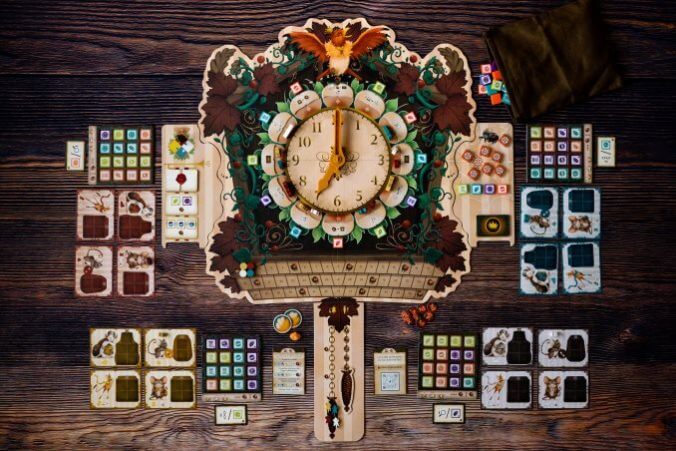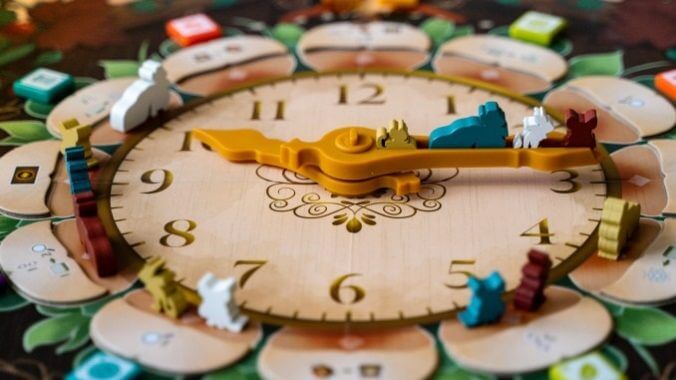Hickory Dickory looks like a light, fun game, with mice running around a clock face, jumping on and off the minute hand to gather various trinkets for points. It is a fun game, but it’s not light and it requires a lot of work to map out your moves well ahead of time so your mice don’t get stuck with nothing to do on the final turn.
In Hickory Dickory, each player has a set of three mouse meeples, each of which has its own card where you can store the items it collects as it circles the clock. Mice move from the minute hand to the 12 numbered spaces, going first to the outer ring, where they may take an item if there’s one there and then take the action associated with that space. When the minute hand reaches 12, the round ends, and all mice sitting on the board (not on the minute hand) move back to the inner ring, from which they can then jump back on the minute hand when it arrives.
Space on the minute hand is limited, however, and you might get bumped off sooner than you’d planned. When a mouse jumps on the minute hand, it moves to the back and every mouse already on the hand moves forward. If there isn’t enough room, one or maybe two will fall off and have to take the action on the outer ring where they’ve been dumped. Each player has one meeple that takes up two spaces on the minute hand, so that one can force two other meeples off, while it’s more likely to find itself pushed off as well.
Those trinkets the mice collect form a significant portion of the scoring in the game. Each mouse has that card that can hold from two to five of these tiles, and can gain them either by getting off the minute hand at a space that has a tile, or by an action that allows the player to draw a tile from the bag at random. There’s also a separate action that allows you to go to the ‘market,’ where you can trade for a wild tile, or trade one tile for two of the four on display. Two action spaces let you deliver these tiles for points—one per tile, then points for tiles of the same color and of the same symbol. After that, you can place any of those tiles on your 4×4 Hunt board on matching spaces, although you may not be able to place some or any of them. And on top of that, there are always two objective cards on display that you can claim if you deliver the tiles shown on them.

That’s the bulk of the scoring in Hickory Dickory, but not all of it. There’s a separate board where you place yet another mouse so it can move up one of the weight cords on the clock, and every time it reaches the top of the cord, you score points, 9 for the first player to do it, then moving down a point every time someone does it until it stops at 4 points. There are also three Relic tiles in the game, which you gain the same way as other tiles, but they’re worth five points if you deliver them to Lord Cuckoo at spot 12.
The scoring complexity isn’t really a problem, because these events tend to happen individually and none of them are that hard to calculate. The game’s real difficulty is in managing your mice—three to start the game, although you can use one specific action space to gain a fourth, the Scamp, who can only carry two items so he’s useful but not game-changing. For three of the four mice, you’re going to be limited to one real move per round—getting on the minute hand or getting off of it. That means you don’t get many opportunities to deliver over the course of a five-round game. There’s one mouse, the Scurrier, who can leap off the minute hand and move ahead up to two spaces, so it can jump back on and travel more, which I think makes it the most powerful of all four mice. (The fourth can take an extra tile from the bag on any draw action and choose among them, rather than just taking whatever they draw.) That all means the main challenge in the game is trying to map out how your mice will move around the board, getting on and off the minute hand, in the most efficient way so 1. you get a good delivery out of each of them and 2. you don’t end up with mice doing nothing in the final round, which has definitely happened to me.
There are some quirks in the game as well that I think could use some help in an expansion. There are Favor cards that can grant you a free action, usually a useful one, or be used to replace a specific tile that’s shown on the card. Those aren’t evenly distributed, however; there are fewer teal tile cards than any other color, and since players’ Hunt boards are also all different, there’s a slight disadvantage if you get the Hunt board where five of the sixteen spaces are teal. There are definitely actions that are more useful than others, and I’m not sure how much the Market adds to the game—wild tiles are great but you don’t have a ton of opportunities to get them.
Games take maybe an hour, probably less the more you play it, although there’s a lot of thinking time between turns and that could easily slow the game down. There’s no text in the game itself, so the real impediment to younger players would be the planning part, and I think that’s pretty significant. It’s a real thinker, and that’s its real strength as a game, with a great, unique mechanic in the movement of meeples on the minute hand (a bit Tzolk’in-esque, but not entirely). There are just some small things, like the sheer number of ways to score, that hold Hickory Dickory back for me from being a truly excellent game.
Keith Law is the author of The Inside Game and Smart Baseball and a senior baseball writer for The Athletic. You can find his personal blog the dish, covering games, literature, and more, at meadowparty.com/blog.

